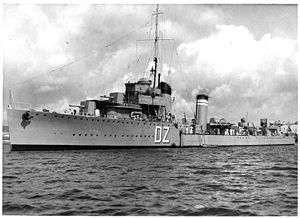Churruca-class destroyer

Destroyer José Luis Diez
|
|
| Class overview | |
|---|---|
| Name: | Churruca class |
| Builders: | SECN, Naval Dockyard, Cartagena. |
| Operators: | |
| Preceded by: | Alsedo class |
| Succeeded by: | Oquendo class |
| Built: | 1923 to 1951 |
| In commission: | 1927 to 1982 |
| Completed: | 18 |
| Lost: | 2 |
| Retired: | 16 |
| General characteristics | |
| Type: | Destroyer |
| Displacement: | 1,536 – 1,650 tons (normal); 2,067 tons (maximum) |
| Length: | 101.00 m (331.36 ft) |
| Height: | 3.30 m (10.8 ft) |
| Draught: | 3.30 m (10.8 ft) |
| Installed power: |
|
| Propulsion: | 2 Parsons turbines |
| Speed: | 36 knots (67 km/h) |
| Range: |
|
| Complement: | 160 |
| Armament: |
|
| Notes: | 240 tons oil fuel |
The Churruca class was a Spanish destroyer class built for the Spanish Navy based on a British design. Eighteen ships were built, with two being sold to Argentina.
The ships were authorized on 17 February 1915 by Navy Minister Augusto Miranda y Godoy. The program planned for four light cruisers, six destroyers, 28 submarines, three gunboats, and 18 coast guard vessels; of these, five light cruisers, three Alsedo and fourteen Churruca-class destroyers, 16 submarines, and the three gunboats were actually completed.
Some of the later ships of the class were completed without the central gun due to an arms embargo during the Spanish Civil War.
The three first ships (Churruca, Alcalá Galiano, and Sánchez Barcáiztegui) were launched between May 1925 and June 1926. When Plus Ultra went to Argentina, she was accompanied by Méndez Núñez and Alsedo. These vessels arrived in Buenos Aires on 7 February 1926. The Argentine Navy was interested in purchasing Alsedo, and the Spanish government on 25 May 1927 provided credit to buy ships in Spain. Argentina eventually purchased Churruca and Alcalá Galiano, renaming them Cervantes and Juan de Garay.
Between 1928 and 1933, Churruca and Alcalá Galiano were launched, along with four other vessels, followed by seven more between 1935 and 1937.
At the start of the Spanish Civil War, the class served on the Spanish Republican Navy and blockaded the Gibraltar Strait. Class members saw some action. Almirante Ferrándiz and Gravina took part in the Battle of Cape Espartel, where Almirante Ferrándiz was sunk by the Nationalist cruiser Canarias. Lepanto, Almirante Valdes, Almirante Antequera, Gravina, Jorge Juan, and Escaño participated in the Battle of Cape Cherchell. Lepanto, Sánchez Barcaiztegui, Almirante Miranda and Grafina were engaged in the Battle of Cape Palos, where Lepanto sank the Nationalist cruiser Baleares with torpedoes. Ciscar was sunk by aircraft in Gijon harbour, refloated by the rebels, and used by them in the final phases of the war.
...
Wikipedia
